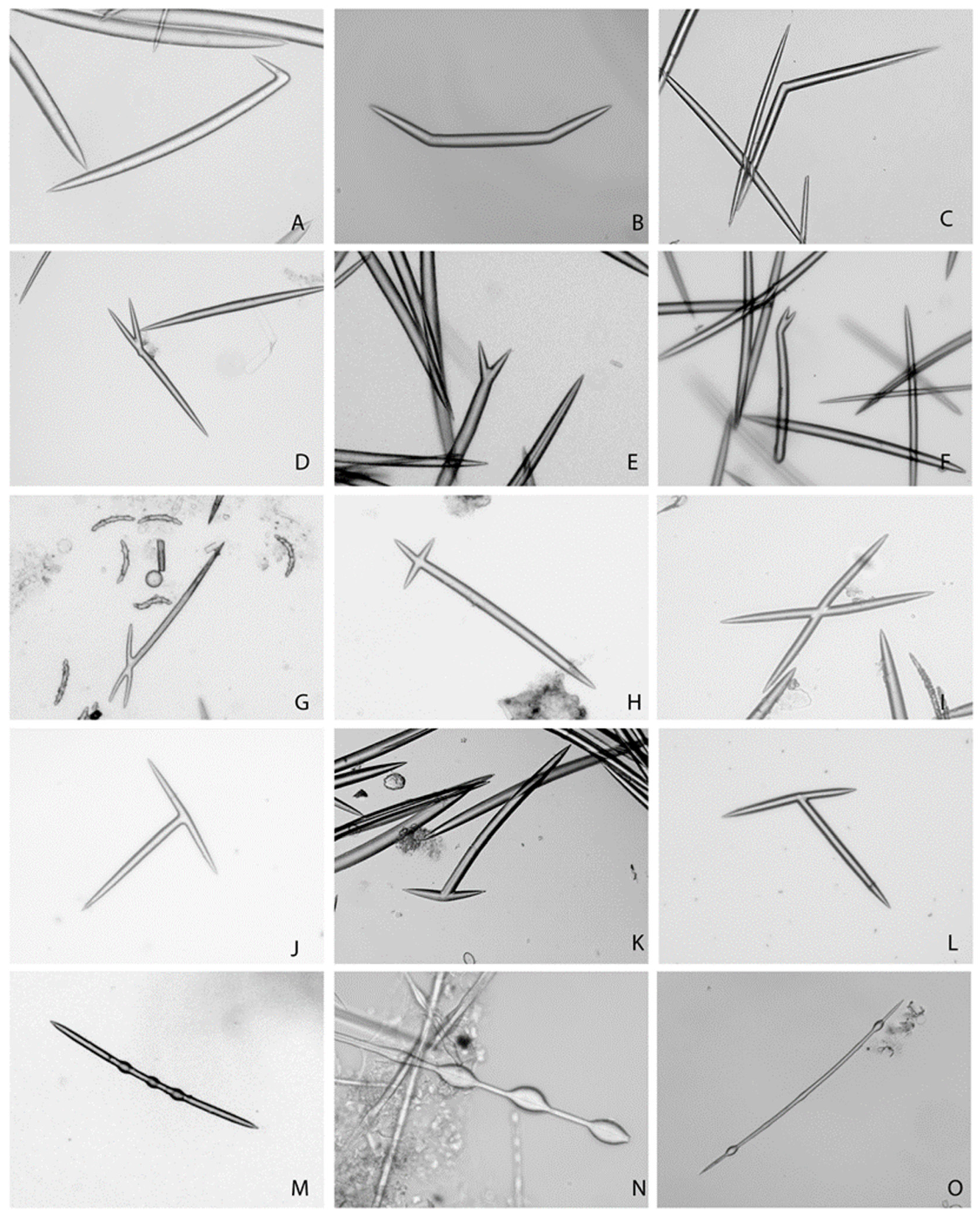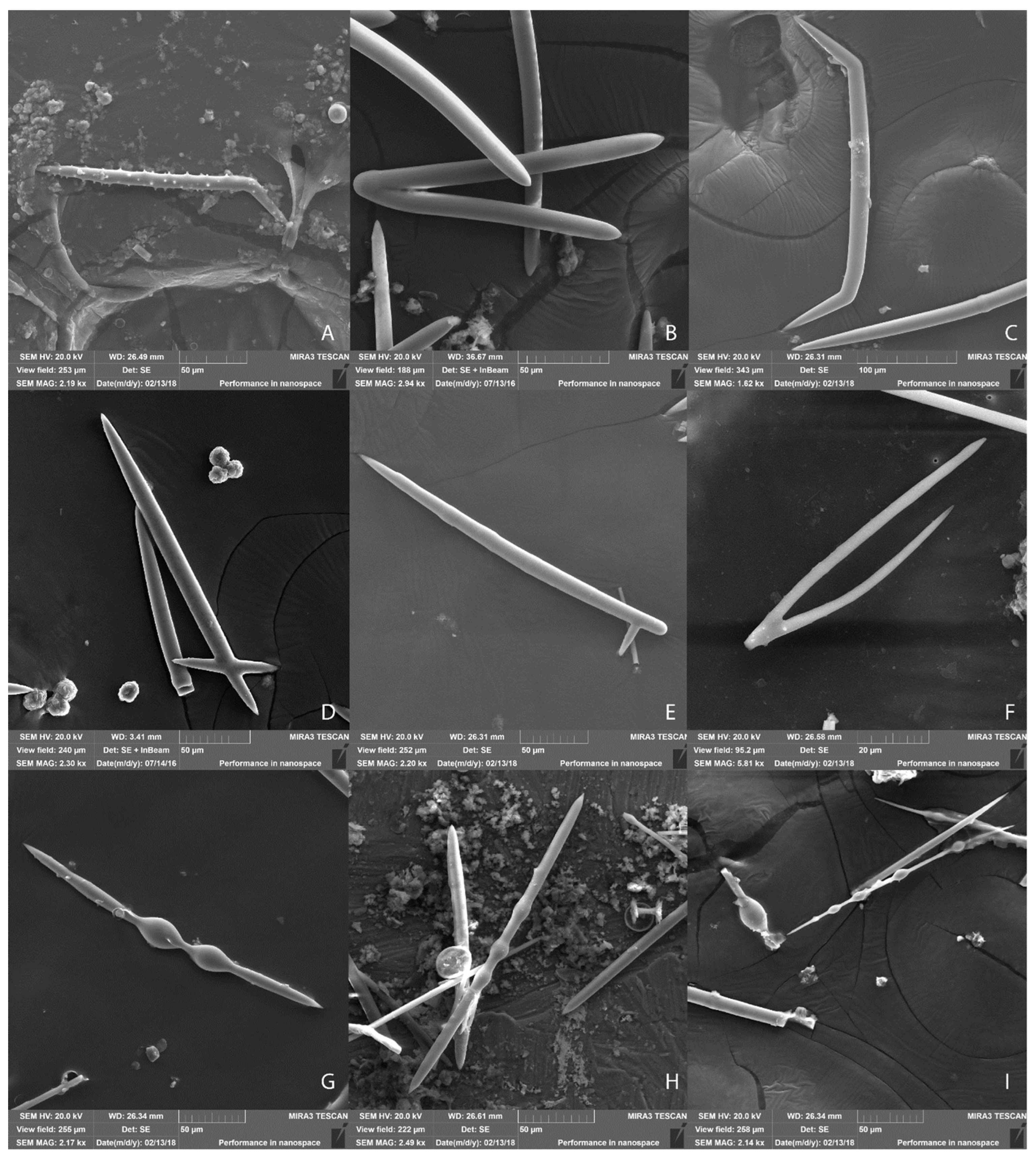Anomalies of Sponge Spicules: Exploring Links to Environmental Pollution
Abstract
:1. Introduction
2. Materials and Methods
2.1. Study Area
2.2. Sponge Sampling
2.3. Analysis of Selected Environmental Parameters of the Rivers
2.4. Spicule Preparation and Light Microscopy
2.5. Quantification and Classification of Spicule Malformations
2.6. Scanning Electron Microscopy
2.7. Statistical Analysis
3. Results
3.1. Sponge Distribution
3.2. Sponge Characteristics
3.3. Spicules Characteristics
3.4. Spicule Anomalies
3.5. Spicule Anomalies in Relation to Environmental Parameters and Pollutants
4. Discussion
5. Conclusions
Author Contributions
Funding
Data Availability Statement
Conflicts of Interest
References
- Pronzato, R.; Manconi, R. Atlas of European Freshwater Sponges. Ann. Mus. Civ. Stor. Nat. Ferrara 2001, 4, 3–64. [Google Scholar]
- Frost, T.M. Freshwater Sponges. In Tracking Environmental Change Using Lake Sediments; Springer: Dordrecht, The Netherlands, 2002; pp. 253–263. [Google Scholar]
- Penney, J.T.; Racek, A.A. Comprehensive Revision of a Worldwide Collection of Freshwater Sponges (Porifera, Spongillidae), 1st ed.; Smithsonian Institution Press: Washington, DC, USA, 1968; p. 184. [Google Scholar] [CrossRef]
- Ricciardi, A.; Reiswig, H.M. Freshwater Sponges (Porifera, Spongillidae) of Eastern Canada: Taxonomy, Distribution, and Ecology. Can. J. Zool. 1993, 71, 665–682. [Google Scholar] [CrossRef]
- Harrison, F.W. Sponges (Porifera: Spongillidae). In Pollution Ecology of Freshwater Invertebrates; Academic Press: New York, NY, USA, 1974; pp. 29–66. [Google Scholar]
- Hustus, K.; Díez-Vives, C.; Mitsi, K.; Nutakki, J.; Kering, V.; Nguyen, I.T.; Spencer, M.G.; Leys, S.P.; Hill, M.S.; Riesgo, A. Algal Symbionts of the Freshwater Sponge Ephydatia muelleri. Symbiosis 2023, 90, 259–273. [Google Scholar] [CrossRef]
- McAuley, D.G.; Longcore, J.R. Survival of Juvenile Ring-Necked Ducks on Wetlands of Different PH. J. Wildl. Manag. 1988, 52, 169–176. [Google Scholar] [CrossRef]
- Williamson, C.E. Crayfish Predation on Freshwater Sponges. Am. Midl. Nat. 1979, 101, 245–246. [Google Scholar] [CrossRef]
- Frost, T.M. Porifera. In Ecology and Classification of North American Freshwater Invertebrates; Thorp, J.H., Covich, A.P., Eds.; Academic Press: New York, NY, USA, 1991. [Google Scholar]
- Resh, V.H. Life Cycles of Invertebrate Predators of Freshwater Sponge. In Aspects of Sponge Biology; Elsevier: Amsterdam, The Netherlands, 1976; pp. 299–314. [Google Scholar]
- Andjus, S.; Lazović, V.; Nikolić, N.; Tubić, B.; Nikolić, V.; Paunović, M. Distribution of Freshwater Sponges in Serbia. Fundam. Appl. Limnol. Hydrobiol. 2020, 76, 48–51. [Google Scholar] [CrossRef]
- Andjus, S.; Nikolic, N.; Marjanovic, A.; Brankovic, M.; Lazovic, V.; Tubić, B.; Čanak Atlagić, J.; Nikolić, V.; Paunović, M. First Record of Freshwater Sponge Trochospongilla horrida Weltner, 1893 in Serbia—A Morphological and Genetic Study. Limnologica 2019, 76, 48–51. [Google Scholar] [CrossRef]
- Richelle, E.; Degoudenne, Y.; Dejonghe, L.; de Vyver, G. Experimental and Field Studies on the Effect of Selected Heavy Metals on Three Freshwater Sponge Species: Ephydatia fluviatilis, Ephydatia muelleri and Spongilla lacustris. Arch. Hydrobiol. Stuttg. 1995, 135, 209–231. [Google Scholar] [CrossRef]
- Poirrier, M.A.; Trabanino, S. Freshwater Sponges (Porifera: Spongillidae) from Lake Ilopango, El Salvador, with Observations on Spicule Malformation in Spongilla alba. Trans. Am. Microsc. Soc. 1989, 108, 211–214. [Google Scholar] [CrossRef]
- Jørgensen, C.B. On the Spicule-Formation of Spongilla lacustris (L.); I Komission hos Munksgaard: Copenhagen, Demark, 1944. [Google Scholar]
- Elvin, D. Growth Rates of the Siliceous Spicules of the Fresh-Water Sponge Ephydatia muelleri (Lieberkühn). Trans. Am. Microsc. Soc. 1971, 90, 219–224. [Google Scholar] [CrossRef]
- Pé, J. Étude Quantitative de La Régulation Du Squelette Chez Une Éponge d’eau Douce. Arch. Biol. 1973, 84, 147–173. [Google Scholar]
- Bavestrello, G.; Bonito, M.; Sarà, M. Influence of Depth on the Size of Sponge Spicules. Sci. Mar. 1993, 57, 415–420. [Google Scholar]
- Subagio, I.B.; Setiawan, E.; Hariyanto, S.; Irawan, B. Spicule Size Variation in Xestospongia testudinaria Lamarck, 1815 at Probolinggo-Situbondo Coastal. AIP Conf. Proc. 2017, 1854, 20034. [Google Scholar]
- Erpenbeck, D.; Galitz, A.; Wörheide, G.; Albrecht, C.; Pronzato, R.; Manconi, R. Having the Balls to Colonize—The Ephydatia fluviatilis Group and the Origin of (Ancient) Lake “Endemic” Sponge Lineages. J. Great Lakes Res. 2020, 46, 1140–1145. [Google Scholar] [CrossRef]
- Francis, J.C.; Harrison, F.W. Copper and Zinc Toxicity in Ephydatia fluviatilis (Porifera: Spongillidae). Trans. Am. Microsc. Soc. 1988, 107, 67–78. [Google Scholar] [CrossRef]
- Falasco, E.; Ector, L.; Wetzel, C.E.; Badino, G.; Bona, F. Looking Back, Looking Forward: A Review of the New Literature on Diatom Teratological Forms (2010–2020). Hydrobiologia 2021, 848, 1675–1753. [Google Scholar] [CrossRef]
- Vasiljević, B.; Simić, S.B.; Paunović, M.; Zuliani, T.; Krizmanić, J.; Marković, V.; Tomović, J. Contribution to the Improvement of Diatom-Based Assessments of the Ecological Status of Large Rivers—The Sava River Case Study. Sci. Total Environ. 2017, 605–606, 874–883. [Google Scholar] [CrossRef] [PubMed]
- Lavoie, I.; Hamilton, P.B.; Morin, S.; Kim Tiam, S.; Kahlert, M.; Gonçalves, S.; Falasco, E.; Fortin, C.; Gontero, B.; Heudre, D.; et al. Diatom Teratologies as Biomarkers of Contamination: Are All Deformities Ecologically Meaningful? Ecol. Indic. 2017, 82, 539–550. [Google Scholar] [CrossRef]
- Richelle-Maurer, E.; Degoudenne, Y.; de Vyver, G.; Dejonghe, L. Some Aspects of the Ecology of Belgian Freshwater Sponges. In Sponges in Time and Space; Balkema: Rotterdam, The Netherlands, 1994; pp. 341–350. [Google Scholar]
- Agency for Environmental Protection. Inland and Groundwater Quality Report—2017; Agency for Environmental Protection: Belgrade, Serbia, 2018. [Google Scholar]
- Manconi, R.; Pronzato, R. Phylum Porifera. In Thorp and Covich’s Freshwater Invertebrates; James, T.H., Christopher, R.D., Eds.; Elsevier: London, UK, 2015; Volume 1, pp. 133–157. ISBN 9780123850270. [Google Scholar]
- Lucey, J.; Cocchiglia, L. Cocchiglia Distribution of Sponges (Porifera: Spongillidae) in Southern Irish Rivers and Streams. Biol. Environ. Proc. R. Ir. Acad. 2014, 114B, 89–100. [Google Scholar] [CrossRef]
- Official Gazette of RS 50/2012. Regulation on Limit Values of Pollutants in Surface and Ground Waters, Sediment, and Deadlines for Reaching Them; Ministry Agriculture, Forestry and Water Management: Belgrade, Serbia, 2012.
- Imsiecke, G.; Steffen, R.; Custodio, M.; Borojevic, R.; Müller, W.E.G. Formation of Spicules by Sclerocytes from the Freshwater Sponge Ephydatia muelleri in Short-Term Cultures In Vitro. Vitr. Cell. Dev. Biol. 1995, 31, 528–535. [Google Scholar] [CrossRef]
- Cao, X.; Fu, W.; Yu, X.; Zhang, W. Dynamics of Spicule Production in the Marine Sponge Hymeniacidon perlevis during in Vitro Cell Culture and Seasonal Development in the Field. Cell Tissue Res. 2007, 329, 595–608. [Google Scholar] [CrossRef]
- Müller, W.E.G.; Wang, X.; Burghard, Z.; Bill, J.; Krasko, A.; Boreiko, A.; Schloßmacher, U.; Schröder, H.C.; Wiens, M. Bio-Sintering Processes in Hexactinellid Sponges: Fusion of Bio-Silica in Giant Basal Spicules from Monorhaphis chuni. J. Struct. Biol. 2009, 168, 548–561. [Google Scholar] [CrossRef]
- Wang, X.; Gan, L.; Jochum, K.P.; Schröder, H.C.; Müller, W.E.G. The Largest Bio-Silica Structure on Earth: The Giant Basal Spicule from the Deep-Sea Glass Sponge Monorhaphis chuni. Evid.-Based Complement. Altern. Med. 2011, 2011, 540987. [Google Scholar] [CrossRef]
- Nakayama, S.; Arima, K.; Kawai, K.; Mohri, K.; Inui, C.; Sugano, W.; Koba, H.; Tamada, K.; Nakata, Y.J.; Kishimoto, K. Dynamic Transport and Cementation of Skeletal Elements Build up the Pole-and-Beam Structured Skeleton of Sponges. Curr. Biol. 2015, 25, 2549–2554. [Google Scholar] [CrossRef]
- Van De Vyver, G.; Holvoet, S.; Dewint, P. Variability of the Immune Response in Freshwater Sponges. J. Exp. Zool. 1990, 254, 215–227. [Google Scholar] [CrossRef]
- Potts, E. Contributions Towards a Synopsis of the American Forms of Fresh Water Sponges with Descriptions of Those Named by Other Authors and from All Parts of the World on JSTOR. Available online: https://www.jstor.org/stable/4061447?seq=1#metadata_info_tab_contents (accessed on 1 November 2019).
- Old, M.C. Environmental Selection of the Fresh-Water Sponges (Spongillidae) of Michigan. Trans. Am. Microsc. Soc. 1932, 51, 129–136. [Google Scholar] [CrossRef]
- Hooper, J.N.A.; Van Soest, R.W.M. Systema Porifera. A Guide to the Classification of Sponges. In Systema Porifera: A Guide to the Classification of Sponges; Hooper, J.N.A., Van Soest, R.W.M., Willenz, P., Eds.; Springer: Boston, MA, USA, 2002; pp. 1–7. ISBN 978-1-4615-0747-5. [Google Scholar]
- Manconi, R.; Pronzato, R. Suborder Spongillina Subord. Nov.: Freshwater Sponges. In Systema Porifera: A Guide to the Classification of Sponges; Hooper, J.N.A., Van Soest, R.W.M., Willenz, P., Eds.; Springer: Boston, MA, USA, 2002; pp. 921–1019. ISBN 978-1-4615-0747-5. [Google Scholar]






| Species/Spicule Sizes (µm) | Megasclere | Gemulosclere | Microsclere | ||||
|---|---|---|---|---|---|---|---|
| Length | Width | Length | Width | Rotule Diameter | Length | Width | |
| E. fluviatilis | 250–380 | 12–19 | 21–25 | 2–4 | 18–23 | / | / |
| E. muelleri | 170–320 | 12–21 | 8–24 | 2–4 | 9–25 | / | / |
| S. lacustris | 160–350 | 5–17 | 18–70 | 3–10 | / | 35–95 | 4–7 |
| E. fragilis | 165–261 | 10–14 | 50–110 | 5–9 | / | / | / |
| T. horrida | 165–245 | 8–12 | 8–10 | 2–5 | 13–15 | / | / |
| Parameter | Tisa, Martonoš | V. Morava Bagrdan | t-Test | |
|---|---|---|---|---|
| Mean ± SD | Mean ± SD | df | Sign. | |
| Watertemperature (°C) | 13.6 ± 9.5 | 14.6 ± 9.1 | 20 | ns |
| Turbidity (NTU) | 23.4 ± 17.6 | 58.3 ± 10.8 | 20 | ns |
| pH | 8.00 ± 0.13 | 8.21 ± 0.16 | 20 | 0.010 |
| Oxygensaturation (%) | 88.6 ± 4.7 | 95.9 ± 10.0 | 20 | ns |
| Conductivity (µS/cm) | 427.4 ± 71.9 | 402.9 ± 41.7 | 20 | ns |
| Ammonia(NH4-N) | 0.067 ± 0.069 | 0.207 ± 0.228 | 20 | 0.048 |
| Nitrates(N-NO3) mg/L | 0.675 ± 0.314 | 1.200 ± 0.455 | 20 | ns |
| Orthophosphate(O-PO4) mg/L | 0.045 ± 0.012 | 0.083 ± 0.031 | 20 | 0.006 |
| Sodium(Na) mg/L | 32.5 ± 8.4 | 13.1 ± 4.5 | 20 | 0.000 |
| Chloride(Cl) mg/L | 38.3 ± 14.5 | 12.9 ± 3.6 | 20 | 0.000 |
| Manganese(Mn) µg/L | 61.6 ± 35.9 | 139.2 ± 73.8 | 20 | 0.028 |
| Zink(Zn) µg/L | 32.6 ± 25.2 | 13.6 ± 7.9 | 20 | ns |
| Copper(Cu) µg/L | 5.8 ± 1.0 | 7.0 ± 3.6 | 20 | ns |
| Led(Pb) µg/L | 2.2 ± 1.1 | 9.5 ± 8.7 | 20 | 0.046 |
| Aluminum(Al) µg/L | 599.3 ± 452.6 | 1086.8 ± 1049.8 | 20 | ns |
Disclaimer/Publisher’s Note: The statements, opinions and data contained in all publications are solely those of the individual author(s) and contributor(s) and not of MDPI and/or the editor(s). MDPI and/or the editor(s) disclaim responsibility for any injury to people or property resulting from any ideas, methods, instructions or products referred to in the content. |
© 2024 by the authors. Licensee MDPI, Basel, Switzerland. This article is an open access article distributed under the terms and conditions of the Creative Commons Attribution (CC BY) license (https://creativecommons.org/licenses/by/4.0/).
Share and Cite
Andjus, S.; Tubić, B.; Vasiljević, B.; Nikolić, V.; Paunović, M. Anomalies of Sponge Spicules: Exploring Links to Environmental Pollution. Water 2024, 16, 332. https://doi.org/10.3390/w16020332
Andjus S, Tubić B, Vasiljević B, Nikolić V, Paunović M. Anomalies of Sponge Spicules: Exploring Links to Environmental Pollution. Water. 2024; 16(2):332. https://doi.org/10.3390/w16020332
Chicago/Turabian StyleAndjus, Stefan, Bojana Tubić, Božica Vasiljević, Vera Nikolić, and Momir Paunović. 2024. "Anomalies of Sponge Spicules: Exploring Links to Environmental Pollution" Water 16, no. 2: 332. https://doi.org/10.3390/w16020332
APA StyleAndjus, S., Tubić, B., Vasiljević, B., Nikolić, V., & Paunović, M. (2024). Anomalies of Sponge Spicules: Exploring Links to Environmental Pollution. Water, 16(2), 332. https://doi.org/10.3390/w16020332








